Middle School Version |
 |
Middle School Version |
 |
East Bay Hills
Version
Script / Screenplay
|
Copyright © September 1994 by Steven P. Kennedy
/ Revised 2003
|
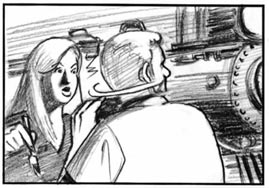 Storyboard Sketches by Alex Mizuno Phone: 650-758-3009 |
FADE IN:
CREDITS ROLLOVER
INT. OFFICE - DAY
CAMERA FINDS computer monitor.
Monochrome program, BEHAVE, flashes on screen.
HOLD ON MONITOR.
KEYBOARD CLACKS as
FLAME LENGTH tables respond to changes in ambient temperature, wind speed, slope and fuel load values.
CREDITS END
Ext. PEACEFUL FOREST - DAY
CAMERA FINDS hole in the forest canopy, rotating and then falling down to shafts of morning sunlight dappling the forest floor.
BIRDS CHIRP, MURMUR OF CONVERSATION,

Sketch by Alex Mizuno
SILVERWARE TAPS AGAINST PLATES.
PAN to elegantly dressed COUPLE (Helen and Jess).
PULL BACK TO REVEAL.
Couple sits at dining table between NILES CANYON RAILWAY STATION CAFÉ, and forest.
Couple pushes salad around on plates. CLINK wine glasses.
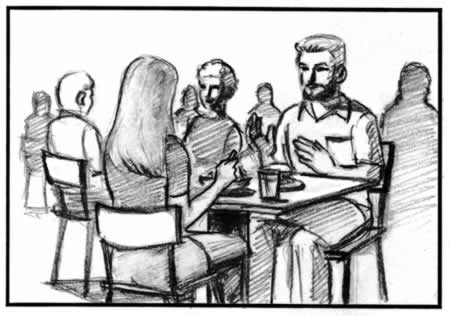
Sketch by Alex Mizuno
(Helen and Jessie) To our new home!
(Later)
(Helen) Sweetheart, let's stop talking about that Oakland fire. That was a long time ago.
(Sips her red wine.)
(Helen) The roads up there weren't wide enough for two cards to pass in opposite directions. Let alone broad enough for a decent hook and ladder to maneuver. That's why we bought the house in Orinda.
(Jessie) But fuel load conditions are just as bad in our neighborhood, right now, as they were in Oakland, then. We need to do something. Fire insurance. Something!
(Helen shakes her head)
(Helen) It can't happen, here. Besides, thick brush is a barrier to fire.
Sound f/x locomotive nears
rush of fore wind. . .
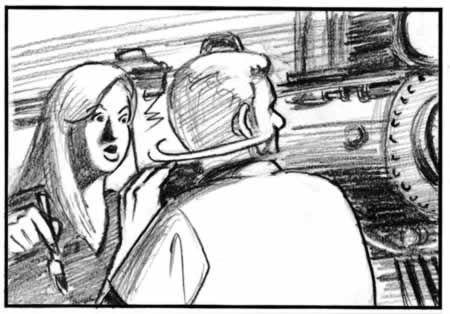
Sketch by Alex Mizuno
RATTLES table contents. RUSTLES couple's composure.
LOUD WHISTLE SHRIEKS WARNING
head-on shot.locomotive barrels down
SMASH CUT to.
oakland/berkeley hills firestorm footage
(Narrator) (Voice 0ver) Trains are a lot like suburban brushfires. They come and they go in the wink of an eye. Yet, the memory of their passing LIVES ON long after the smoke has cleared.
Ext. brushfire - day
(Narrator) (V. O.) Nature used to have a way of keeping brushfires on schedule. Cool-burning, ground-hugging fires seldom caused alarm to man or beast.
Ext. construction site in wooded hills - day
(Narrator) (V. O.) However, the construction of homes in fire-prone areas has altered the cycle of nature and put nature's trains way behind schedule.
(oakland/berkeley hills firestorm footage)
(Narrator) (V. O.) When nature does roll the train? It's the fireball express. (PAUSE) If we choose to heed the lessons of the Oakland/Berkeley Hills Firestorm of 1991, we can slow down the train and make it stop! When and where we want it to.
Ext. suburban house - day
(Narrator) (V. O.) That's the driving force behind a new concept in urban planning called vegetation management.
CAMERA FINDS low fuel zones around house.
(Narrator) (V. O.) Vegetation management! Create a network of low fuel zones where a fire can be stopped before it blows through a suburban neighborhood.
Mt. Tamalpais - day
(Narrator) (V. O.) Soon after the devastation of the Oakland/Berkeley Hills Firestorm of 1991, it became apparent to Marin County Fire Officials that towns and communities nestled around Mount Tamalpais were, seasonally at least, in mortal danger.
DAGUERREOTYPE SHOTS of Native Americans burning brush.
(Narrator) (V. O.) Where the Native Americans used to burn on this mountain every three to five years, there was now a fifty year accumulation of brush. More than enough for a cannonball run.
Amtrak blasts by - day
(Narrator) (V. O.) Marin County Water Department officials were concerned that a major fire would FLOOD silt and ash into the reservoirs. Thereby, reducing their capacity and complicating the water treatment process.
Animal wildlife on Mount Tamalpais - day
(Narrator) (V. O.) Open space district resource managers were also concerned what impact a major fire would have on native plants and animal communities.
Another shot - day
(Narrator) (V. O.) Given wide-spread public opposition to controlled burning, it was evident that a new approach was needed. So an environmental analyst firm was hired to lay the foundation for a Vegetation Management Project or VMP.
Marin countryside - day
(Narrator) (V. O.) This ground-breaking BASE LINE STUDY determined the nature of the vegetation that originally flourished. Its current state. And the likelihood of it's future existence, given the current land management practices.
Vegetation shots - day
(Narrator) (V. O.) VMP detailed how, out of a total study area of 20,000 acres in Marin County, 1,000 acres would be treated. Control burn to be used in strategic areas on only 300 acres.
Ext. countryside and suburbs - day
(Narrator) (V. O.) The situation is similar in this area regarding the abundance of flammable vegetation. But, here, the residents rely on water imported from the Delta. With no problem that the water supply will be in danger, this removes the water department as a major player in deciding how flammable vegetation should be handled.
San Francisco bay - day
(Narrator) (V. O.) creeks in these watershed, generally, flow into San Francisco Bay or the Pacific Ocean rather than into reservoirs. Effectively, this puts the fuel reduction dilemma into the hands of the people: individual homeowners whose property backs up to a bushy hillside or canyon.
Ext. work crew clearing brush - day
(Narrator) (V. O.) In this County there are inmate work crews doing brush removal projects. But, they are generally restricted by budget to work on high priority projects on public property such as city park and open space areas.
Land around private home - day
(Narrator) (V. O.) Private homeowners whose fire threat arises from land outside the scope of these work crews, must hire independent contractors or do the work themselves. VEGETATION MANAGEMENT wraps up environmental, public safety, view-scape and property value issues in one neat package.
Ext. Brushy hillside - day
PAN view of suburbia below.
(Narrator) (V. O.) In the larger scheme, an integrated approach is necessary. (PAUSE) Let's meet one of those independent contractors who'll share some secrets of good vegetation management.
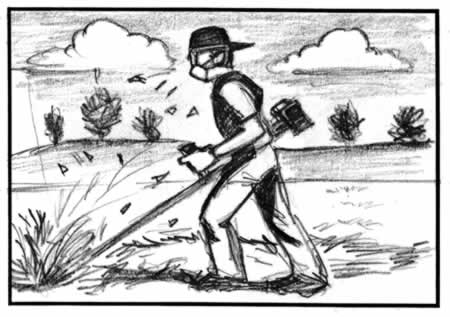
Removes face shield. SEES Jess & Helen
(Teo) Hi! Thanks for stopping by. I could use a breather.
(Takes a sip of water from canteen. Sits down at crude table.)
(Teo) Yeah, I figure another three hours on this project and I'll have it about done. You know, my business card says I'm a tree cutter but that gives people the impression that I'm some kind of a lumberjack. Actually, I consider myself to be in a growth industry called.
(Teo beams.)
(Teo) Vegetation Management.
QUICK CUT TO Teo HAULING and WINCHING debris down to truck.
(Teo) (V. O.) Ya know, some these homeowners hand me projects large enough to experiment with different methods of hauling the cut brush down to the truck.
(Teo CHAINSAWS brush debris in pick-up bed of truck.)
(Teo) (V. O.) Usually, one hour of cutting brush makes for two hours of loading and hauling away. This project, I rigged up a cable and pulley system to skid the cut brush across the hillside, then down to my truck.
(Back to Teo)
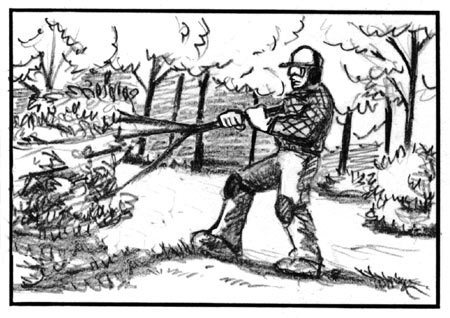
Sketch by Alex Mizuno
(Teo) I just found this so much faster than clipping the brush, you know, (Quick hand movements) ZING-ZING! One branch at a time!
(Later)
(Teo GESTURES towards the house.)
(Teo) Now, while I'm being paid by the homeowner to reduce the risk that a fire might ROAR up the hill and take out his house. I am a member of the Sierra Club. And I do take the environment into consideration when I'm deciding what goes and what stays.
(Teo RISES. Walks towards tree.)
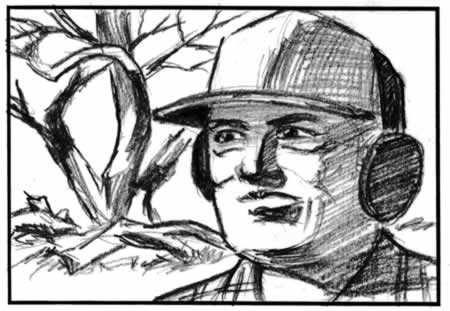
Sketch by Alex Mizuno
(Teo) Take this dead oak for example. It was young and strong before the Spaniards arrived. Now, the sudden oak death fungus has killed it and it is just firewood. But, it's kind of scenic and the trunk could make a great habitat for owls and woodpeckers for the next hundred years.
(Heavy branch snaps off dead oak with loud CRACK! FALLS to earth with a THUD.)
(Teo) The homeowner decided not to take the risk of leaving it. So, he'll get the firewood, instead.
(Later)
(CLOSE ON Teo's arms smeared with mud.)
(Teo) Poison oak and oak trees. (Heavy sigh) Now, there's a combination. I use lanolin on my skin and I set up a gravity fed, solar heated shower right here on the job site. Fortunately, most of what you gotta worry about in poison oak is the leaves. They turn red and fall off in the winter.
(Teo looks around.)
(Teo) If it wasn't for the poison oak, I could burn some of this brush in piles. But, there's a permitting process. And it's just more hassle than it's worth.
(Later)
(Teo sizes up his work thus far.)
(Teo) When I started on this project, it was really bushy here. I've already made several trips to the dumps and it's starting to look pretty good. (Teo's arms stretch out towards the hill.) Look how steep this hill is! It could have been bulldozed the hill but hand removal of bushes causes a lot less erosion. When I'm done clearing, I'll reseed it with wild flowers in the sunny areas. I told the homeowner, I could make it look like a park.
(Makes a throwing motion as if scattering seed.)
(Later)
(Teo stands at pile of debris.)
(Teo) Most of what I take out is Scotch broom, poison ivy, coyote brush, sticky monkey flower and wild oats.
(Teo extracts a Scotch broom plant from ground.)
(Teo) Scotch broom and wild oats are the exotics. Shoot! Every year, this county loses more plant and wildlife habitat to exotic invasives than developers putting in homes and roads.
(Turns Scotch broom in his hand.)
(Teo) We just don't have any insects or animals that go to town on Scotch broom. it looks nice. Got a pretty yellow flower that bees like.but, it just takes over.
(Tosses Scotch broom into brush pile.)
(Teo) Scotch broom comes back quickly from seeds dropped the previous year. I'll make a follow-up visit in six months to yank out volunteers.
(Teo walks up hill.)
(Teo) The natives that grow back here attract deer and rabbits with succulent new growth. The only trees I'm eager to take out are the ones that just don't belong.
(FLAPS hand at eucalyptus.)
(Teo) Eucalyptus is high on my list. It smells good but it's always shedding. Lots of native plants get drowned by the steady rain of debris.
(QUICK CUT TO Oakland/Berkeley Firestorm.)
(Teo) (V. O.) Heard, once, eucalyptus was 80% of the fuel the went up in the Oakland/Berkeley Hills Firestorm.
(Back to scene - day)
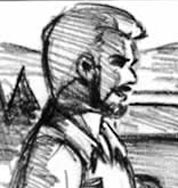 (Teo
stands before eucalyptus.)
(Teo
stands before eucalyptus.)
(Teo) Hardware stores had a run on saws and loppers all over Berkeley afternoon of the fire. (Shakes his head sadly) Too little! Too late!
(Teo down at truck.)
(Teo) Once the initial cleaning is done, annual vegetation management is easy. No real secret to what I do. Just be careful with the tools and watch out for poison oak.
(Puts tools in truck.)
(Teo) Lots of my customers do annual maintenance themselves, but, I keep tabs on 'em. Good for business. Ol' Teo is the cheapest fire insurance there is.
(Teo waves to leave. Turns back.)
(Teo) Want to know more about native plants? Go see Don Coyne. He knows more than me. Shoot! He even grows 'em and eats them.
(Helen and Jess wave good-bye to Teo.)
Ext. canyon - day
CAMERA PANS canyon to bay.
Ext. hillside with garden- day
Bamboo rake and blue plastic tarp lay on ground.
DON COYNE, athletic, outdoorsman, wood sculptor, methodically sweeps hillside with weed eater.
(Later)
(Don turns off weed eater. APPROACHES Jessie. Points to FENCE.)
(Don) Built that fence myself. Got my corns, beans and pumpkins in there. (Motions with head) There's a deer in that canyon. And, they're hungry! Those succulent native grasses are for for them. The garden's for me.
(Later)
(Don sits. Looks up hillside.)
(Don) There's bobcats out there. Raccoons. Tree squirrels. 'Possums. An occasional mangy coyote. And skunks! Nesting right under my neighbor's deck. (LAUGHS)
(Later)
(Don) Yeah, Teo is right on that. I know a lot about native plants. But, I'm just getting into the grasses. I always assumed, the grasses were natural. But, no-oo! All of those hyper competitive annuals came over with the cows and sheep. Yup, this all used to be just overgrazed range land. Anyway, let me show you what I've done so far. (Grasses) They're hard to re-establish once the area's been disturbed. Planted some native bunch grasses. Some from seed. Some I bought in starter pots.
(DON HOLDS up pot.)
(Don) This is blue wild rye. It should do well, here, on the edge of the oak woodland with plenty of sunshine. It provides good forage and cover for wildlife. Good for controlling erosion. Tolerates clay soil. Should grow about waist high.
(Don picks up another plant.)
(Don) This is a California brome. Excellent for recovering areas overgrown with weeds.
(Don pulls out wild oat plant.)
(Don) There's not much that competes with wild oats. But, for fire protection, I've got California oat grass.
(Holds up california oatgrass pot.)
(Don) It stays green late into summer without watering. So, it really has to be a hot day before it'll burn. And, if I water once in a while, it really shouldn't. It's also longest lived of the native grasses, so it'll be here for awhile. I'm going to plant a lot of this.
(Don walks over to tarp.)
(Don) And this stuff?
(FOOT POKES pile of mown grass on tarp.)
(Don) Is going straight into the gully.
WALKS OVER to gully.
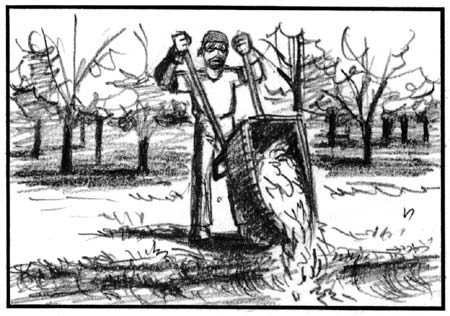
Sketch by Alex Mizuno
(Don) This ditch wasn't near this deep when I was a kid. (DUMPS IT IN) And this is just from street run-off. See the end of the culvert, there.
(Pan to culvert)
(Don) (V. O.) If all the vegetation on this hill was burned off in a fire, there'd be massive amounts of run-off every time it rained. There'd be nothing to throw in the culvert to stop the run-off.
CAMERA GOES WITH Don's return to work area. Grabs rake. Leans on it.
(Don) There's a gully across the canyon, there, that's thirty feet deep with SHEER walls.
(Pan to gully)
(Don) When it rains, all the water from the storm drains pours down this canyon, then, out to the bay. No chance to soak into the ground. It's kind of like what happens with a bad fire.
(QUICK CUT TO Oakland/Berkeley Firestorm)
(Don) (V. O.) The pine needles in the soil gets so hot, it can form a hydrophobic layer like wax cardboard where the water can't penetrate. It just runs off. That's why there's these terrible floods after every major fire.
(Stock shot of flooding)
(Don) (V. O.) Water can't soak in. There's nothing to hold it. Mud City. Then, things dry up. People build a few more houses, it all grows back and the whole thing happens again. Crazy! There's got to be a better way. The time to stop erosion is before it gets serious, you know.
Ext. mountains above Berkeley campus - day
Teo with husqavarna
(Narrator) As we've seen, there are several different varieties of fuel reduction. If you've gotten the go ahead, you can do it yourself or pay to have it done.
(Don bedding his plants)
(Narrator) (cont.) The wise homeowner who gets this far will re-plant with fire-resistant shrubs or native grasses. Even in the poorest soil, this will provide year-round protection from erosion and fire and be a source of beauty as well.
(Ext. Yerba Buena nursery - day)
(Narrator) (cont.) Let's see how our newly enlightened first-time homeowners will simultaneously manage a fuel break for beauty, erosion control, habitat and fire protection.
CAMERA FINDS AND GOES WITH station wagon as it maneuvers Skyline Blvd.
TURNS INTO Yerba Buena NURSERY.
Past cabins, a pond, quarry and a barn.
WHITE FARM HOUSE fronting greenhouses, sheds and barns.
Station wagon parks in stall. EXIT Helen.
Helen wears a long dress. HOLDS long shopping list in hand.
QUAIL CALLS
Helen walks to GREENHOUSE. Pokes head in. Sees only FERNS.
(Helen) Hello-oh! Anybody here?
No reply.
WALKS down road to Quonset hut with office inside.
SIGN states: RING BELL FOR SERVICE.
Helen grabs rope like cable car gripman and RINGS.
Female nursery WORKER clad in blue jeans approaches.
Slips cordless phone in back pocket.
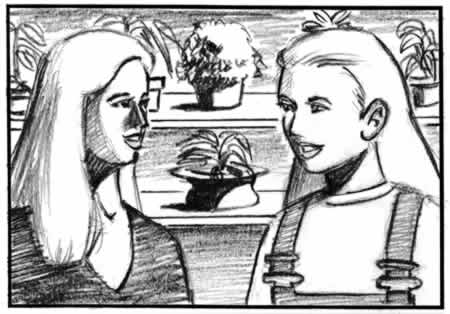
(Helen) I want to buy some plants.
(Helen hands list to worker. Reads down list.)
(Worker) Some of these we have. Some we don't. What kind of garden are you trying to grow?
(Helen) It's not a garden. It's to protect the house.from fire. My husband and I want good plants outside the fence.
(Worker) You mean fire resistant? Plants that hold the soil?
(Helen nods.)
(Worker) I can help you. How many square feet?
(Helen) Our lot is about eighty feet wide. Some men came in. The area they cleared is from here to that big tree.
LARGE FIR WITH SPANISH MOSS on lower branches.
(Worker) That's about fifty feet.
(Helen) And, it's all downhill.
Ext. Helen and Jessie's property on side of hill - day
Burnt soil in back of house.
(Worker) (V. O.) Fifty by eighty. That's four thousand square feet. One bush every ten square feet. That's about four hundred plants.
(Helen) (V. O.) (In shock) Four hundred? Oh, no. Not that many. That won't even fit in my wagon. (giggles) And money doesn't grow on bushes, you know.
(Back to Yerba Buena nursery)
(Worker brings wheelbarrow for Helen.)
(Worker) Why don't you put in the wheelbarrow whatever you can afford? I've also got wild flower seed you can plant yourself.
(Helen) Oh, wonderful. My children will love that. The workmen burned all that brush last week. Can we plant the seeds in the ash?
(Worker) Definitely. Ash is good fertilizer. And the heat from the fire sterilizes the soil and kills the weed seed.
Ext. Helen and Jess's property - day
(Helen) (V. O.) There was so much brush. And that blackened scar is so ugly. But, I guess they had to do it.
(Worker) (V. O.) Yes, brush just keeps on growing.
Ext. california brush fire - day
(Worker) (V. O.) Brush fires have been part of the California landscape for thousands and thousands of years. That is, until we came along. Anyway, after a fire, most brush will come back from the crown because the roots are still alive.
(Back to Yerba Buena nursery)
(Helen and Worker push wheelbarrow down road.)
(Helen) (shocked) Does that mean, most of what the worker's chopped down will be back?
(Worker) In time, yes. Unless, you use an herbicide to poison the roots. Or, establish these plants, nearby. (holds Helen's list) They'll compete for available sunlight.
(Helen) (shakes head) I don't like putting poisons in the environment.
(Worker) All the natives are fire adapted. The plants on your list can be heavily pruned when they get too big. Then, vigorously, re-sprout like nothing happened.
(Helen) What do you have that's on my list?
(Bladderpod)
(Worker) (V. O.) We have bladderpod. That's over here.
(Worker lifts one)
(Worker) They're five bucks each.
(Helen) I'll take four.
(Worker hands Helen bladderpod. Tears off sprig from another plant. Crumples it.)
(Worker) Here, smell this.
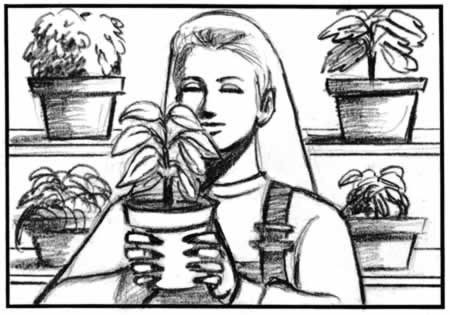
Sketch by Alex Mizuno
(Helen) (sniffs) Oh, that's wonderful!
(Worker) It's Sand Hill Sage. When it's in bloom, the fragrance is heavenly. (PAUSE) Where do you live? Are you in the fog belt?
(Helen) No, we're East of the Caldecott. We get wind. But, only morning fog.
(Worker) Does the hillside get afternoon sun?
(Helen) Morning.
(Worker) That puts you on a south facing slope. Fires burn hotter on the south face of a slope.
(Helen) And, we're at the top of the hill.
(Worker) That's a double-whammy.
(Helen) My husband insists we do everything fire safe.
(Ext. man cleans rain gutters - day)
(Helen) Every month, he's up on the ladder, cleaning pine needles out of the rain gutters. he even wants to go in with a neighbor for one of those foam spray units to cover the house with foam.
(Int. Nursery aisle - day)
(Helen and Worker push wheelbarrow. Worker picks up another plant container.)
(Worker) This chaparral currant does a good job of holding soil. Also, provides cover and food for quail. See our resident flock, driving in?
(Helen) No, but I heard them. Such a beautiful sound.
(Worker) That's the male calling his flock together.
(Helen) How much for chaparral currant?
(Worker) One gallon container - $6. 00 each.
(Helen) I'll take five. Do you take VISA?
(Worker) Of course.
(Wild strawberry plants.)
(Worker) (V. O.) There's wild strawberry and stone crops over here. The strawberry's an herbaceous perennial. Needs a little water, now and then.
(Helen) (V. O.) No problem, there.
(Worker) (V. O.) Stone crops are succulents.
(Stone crop plants)
(Worker) They offer the best fire retardation and drought resistance.
(Helen) (V. O.) (Excited) Let's round out the wheelbarrow with those and come back for more.
(HELEN AND WORKER PUSH WHEELBARROW out to station wagon.)
(Helen) You're a long way from the nearest fire station. What precautions have you against fire?
(Worker) Fire evacuation plan, if worst comes to worst. We've got porta-pumps to drop in the ponds if the electricity goes out. We can pump water from the well.
(Coiled up fire hose)
(Worker) We've got fire hose all coiled up and.
(Ladders against rear side white farm house)
(Worker) (cont.).a bunch of ladders against the back of that old house, in case, the roof catches.
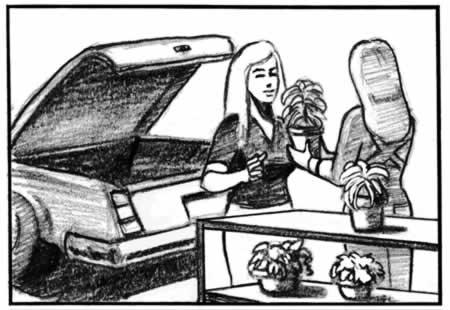
(Helen and Worker arrive)
(Helen) You know, getting fire insurance these days is difficult. They won't write a new policy unless someone else drops out.
(Worker) Tell me about it.
(Helen and Worker unload wheelbarrow.)
(Worker) Plants we can re-grow. Greenhouses can be rebuilt. If we had to evacuate, there're a few plants I'd grab. But I wouldn't take any chances.
(Helen) (nods) Not worth the risk.
(Worker) (shrugs) A fire would prove how fire-adapted these natives are. It'd set us back but we'd recover. We all fear the worst, but, hope for the best.
(Helen) It's just one of those things you have to plan for.
(Ext. Sunol train station depot - day)
(Narrator) (V. O.) Planning for fire is part of the cost of living in a Mediterranean climate. Spring house cleaning should include painting the house, mowing the lawn and cutting the brush back. How aggressively you go about it depends on factors such as health, wealth and degree of perceived risk.
(Steam train pulls up. Stops.)
(Narrator) (V. O.) To be truly fire-safe requires the participation and cooperation of individuals, neighborhoods and local governments. With foresight and careful planning, our homes can be made safer and our cherished native plants and animal communities restored to their former glory. (PAUSE) All aboard!
Roll end credits
Steam train pulls from station.
Cast and crew, aboard, SMILE and WAVE.
FADE OUT.
Steven P. Kennedy-Author
The Pitch The Script Venues & Showings Endorsements Show Me the Money! Fresh Approaches Food For Thought